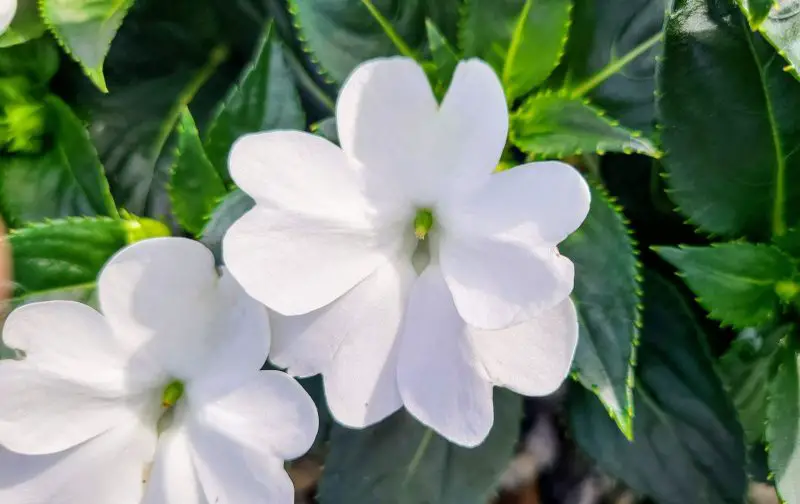Impatiens are bright, colorful flowers that bring life to shady gardens and patios. Gardeners love them for their long blooming season and low-maintenance nature. These plants grow quickly and fill spaces with rich color, making them ideal for borders, containers, and hanging baskets. However, giving impatiens the right amount of sunlight is essential. Too much sun can burn their soft leaves, while too little light can cause weak stems and few blooms. Finding the perfect balance of light keeps them strong and full of flowers.
Light plays a vital role in every stage of impatiens growth. It influences how fast they bloom, how vibrant the colors appear, and how compact the plants stay. Most varieties prefer bright but indirect light, similar to what they would receive on a forest floor. When planted under the correct light conditions, impatiens can bloom beautifully from spring until frost. This guide will show you how much sun impatiens need, the best spots to grow them, and how to keep them thriving in any environment.
Understanding the Light Requirements of Impatiens

Light is one of the most important factors that determine how impatiens grow, bloom, and maintain their color. These beautiful plants naturally come from warm, tropical forests where tall trees provide shelter from direct sun. In these environments, impatiens receive filtered or dappled sunlight that gently reaches their leaves. This balance of brightness and protection shapes how impatiens behave in gardens today. They perform best under partial shade, where they get enough light to bloom but not so much that it scorches their soft foliage. When the light level is right, impatiens grow full, bushy, and covered with vibrant blossoms.
In cooler climates, impatiens can tolerate several hours of gentle morning sunlight, especially when the temperatures stay mild. The morning sun helps them photosynthesize efficiently and boosts their energy for strong flowering. However, when afternoon temperatures rise, their delicate leaves can lose moisture quickly and become stressed. That’s why gardeners in hot or dry regions should plant them in spots that receive filtered or indirect light for most of the day. Porches, north-facing gardens, or areas shaded by taller plants usually provide ideal growing conditions. By studying your garden’s sunlight pattern, you can easily locate the best environment for your impatiens to thrive.
The balance between light and shade not only affects the plant’s appearance but also its overall health. Too little sunlight results in weak stems and few flowers, while too much direct exposure causes fading or wilting. Impatiens prefer consistent, moderate brightness — bright enough to promote steady growth but soft enough to keep their leaves cool. Providing that balance encourages long-lasting blooms and dense green foliage throughout the growing season. When impatiens receive the right amount of light, they reward gardeners with continuous, dazzling color that brightens shaded spaces effortlessly.
How Much Sun Do Impatiens Actually Need
Impatiens thrive in environments where sunlight is soft and indirect, rather than harsh and direct. Most varieties of impatiens prefer partial shade, which usually means around four to six hours of filtered or dappled sunlight each day. This type of lighting keeps the plants energized without overwhelming them. When grown in full shade, impatiens can still survive, but they tend to produce fewer flowers and weaker stems. On the other hand, too much sun—especially the strong afternoon light—can scorch their tender leaves, causing them to wilt and lose color. The key is finding the balance between light and protection.
In cool or mild climates, impatiens can handle a bit more sunlight, particularly the gentle morning rays. Morning sun combined with afternoon shade provides the perfect growing condition. This allows the plants to photosynthesize efficiently in the early hours, then rest in cooler shade later in the day. In contrast, gardeners in hot or tropical areas should avoid exposing impatiens to intense midday or afternoon sun. If the heat is too strong, the soil dries quickly, and the plant may struggle to recover even with regular watering. Providing them with light that mimics their native forest habitat ensures consistent, healthy growth.
Observing your plants will help you determine if they’re getting the right amount of sunlight. If impatiens look stretched or have fewer blooms, they likely need more brightness. If leaves turn yellow or develop dry edges, they may be receiving too much sun. Adjusting their position by a few feet or offering light shade from nearby plants can make a noticeable difference. When impatiens receive balanced light, they stay compact, colorful, and full of blooms all season long. Proper sunlight management is the foundation of growing strong, resilient, and beautiful impatiens.
Differences in Light Needs Between Impatiens Varieties
Not all impatiens varieties have the same light requirements, and understanding these differences helps you grow them more successfully. The two most common types are traditional impatiens (Impatiens walleriana) and New Guinea impatiens (Impatiens hawkeri). Traditional impatiens prefer shaded or partially shaded areas and tend to suffer when exposed to intense sunlight. They perform best with bright, indirect light or a few hours of gentle morning sun. Their soft, thin leaves are not adapted to handle high heat, so too much sun can cause them to wilt quickly. When grown in proper shade, however, they produce dense, colorful blooms that last for months.
New Guinea impatiens are more sun-tolerant and can handle brighter conditions. They have thicker leaves and stronger stems that allow them to withstand more direct sunlight, especially in cooler climates. These plants can grow in spots that receive up to six hours of direct sun each day, as long as they are watered regularly and protected from harsh afternoon rays. Because of their tolerance for light, New Guinea varieties are ideal for borders, patios, and areas that get both sun and shade. Their flowers are typically larger and glossier, offering vibrant colors even in sunnier locations.
There are also hybrid impatiens varieties bred for flexibility in light conditions. These modern types can adapt to both shaded and sunny areas, making them perfect for gardeners who want versatility. However, even these hybrids benefit from partial shade during the hottest part of the day. Knowing which type of impatiens you’re growing allows you to tailor the lighting conditions more precisely. Matching each variety’s sunlight preference not only improves flowering but also keeps foliage rich, lush, and resistant to stress throughout the growing season.
Signs Your Impatiens Are Getting Too Much Sun
When impatiens receive more sunlight than they can tolerate, they quickly show signs of stress and damage. The first symptom most gardeners notice is leaf discoloration. Leaves may start losing their deep green color, turning pale yellow or light brown. Over time, the edges may become crispy and dry, especially during the hottest parts of the day. This is a clear sign of sunburn, caused when the delicate foliage overheats and loses moisture faster than the roots can replace it. If the sun exposure continues, the affected leaves may curl, shrivel, and eventually fall off, leaving the plant sparse and weak.
Blooms are also heavily affected by excessive sunlight. Flowers may fade quickly, lose their bright color, or fail to open completely. The intense rays can scorch the petals, causing them to wilt within a day or two. In extreme cases, the plant might stop blooming altogether, diverting its energy toward survival instead of producing flowers. This decline in flowering often comes with stunted growth, as the plant struggles to balance energy production under stressful light conditions. Impatiens grown in pots or hanging baskets are particularly vulnerable since the soil in containers dries out faster, worsening the stress caused by heat and direct sunlight.
If you notice your impatiens wilting even when the soil is moist, it’s a strong indication that they are receiving too much sun. Relocating them to a spot with filtered or partial shade usually solves the problem. For garden beds, planting them beneath taller shrubs or trees provides natural protection. Mulching around the roots helps retain soil moisture and reduces heat stress. Once impatiens are moved to a gentler light environment, they often recover within a week or two, producing new, healthy leaves and vibrant blooms once again. Consistent light management ensures their beauty lasts all season.
Signs Your Impatiens Are Not Getting Enough Sun
While impatiens are known for thriving in shade, they still need some sunlight to grow strong and bloom continuously. When they don’t receive enough light, the first sign you’ll notice is reduced flowering. The plant will produce fewer blooms, and the ones that do appear may look smaller and paler than usual. Impatiens use sunlight to create energy through photosynthesis, so without sufficient light, they simply don’t have the energy to sustain regular blooming. Over time, this lack of energy leads to slow growth, sparse flowers, and a dull overall appearance that makes the plant look tired.
Another symptom of insufficient light is leggy growth. The stems stretch toward the nearest light source, becoming thin, elongated, and weak. This uneven growth causes the plant to lose its compact shape, making it more prone to bending or breaking. The leaves may appear thinner, lighter in color, and spaced farther apart than normal. In extreme shade, the lower leaves might drop off, leaving the stems bare near the base. While impatiens can tolerate low light better than many other flowering plants, they still require at least a few hours of indirect or filtered sunlight each day to maintain balance between foliage and flowers.
You can easily test if your impatiens need more sun by observing how they behave over a week. If blooms remain sparse despite proper watering and fertilizing, it’s likely they need a brighter location. Try moving them to an area with gentle morning sun and light afternoon shade. Within two to three weeks, the plant should respond with stronger stems, greener foliage, and more abundant flowers. Providing consistent but moderate light allows impatiens to thrive naturally, creating the dense, colorful display they are famous for in shaded gardens.
How to Find the Perfect Spot for Impatiens in Your Garden
Finding the ideal location for impatiens in your garden is the key to keeping them healthy and full of flowers all season long. Start by observing how sunlight moves across your garden during the day. Impatiens prefer bright, indirect light or partial shade, so look for areas that receive gentle morning sun followed by shade in the afternoon. Morning sunlight provides the energy needed for strong growth, while afternoon shade protects the plants from heat stress. If your garden gets intense sunlight throughout the day, consider planting impatiens under taller plants, trees, or on the shaded side of a structure where the light is filtered.
Soil conditions also play an important role in choosing the right spot. Impatiens prefer moist, well-drained soil that stays consistently damp but never soggy. Locations with good airflow and light shade help prevent fungal problems while maintaining healthy foliage. If you’re growing impatiens in containers or hanging baskets, you have more flexibility. You can move them around until you find the perfect balance of light and shade. This mobility is especially useful during extreme heat, when a quick shift to a shadier area can prevent damage. Always monitor how your plants react over several days to confirm the spot provides the right lighting conditions.
The perfect location should allow impatiens to receive enough light for photosynthesis without overheating or drying out. When planted correctly, they grow bushy, vibrant, and covered in colorful blooms that last for months. Once established, impatiens can adapt well to slight changes in light, but they still rely on consistency. Avoid moving them too frequently once they begin to flower, as stability encourages stronger roots and better flowering performance. With careful placement, your impatiens will thrive naturally, bringing lush color to every shaded or semi-shaded part of your garden.
Tips for Growing Impatiens in Different Light Conditions
Growing Impatiens in Partial Shade
Partial shade provides the most balanced growing conditions for impatiens, allowing them to receive four to six hours of filtered sunlight each day. This environment replicates their natural forest habitat, where soft light filters through tree canopies. Under partial shade, impatiens can photosynthesize efficiently without overheating, which results in fuller plants, greener leaves, and longer-lasting blooms. Morning sunlight is especially beneficial because it energizes growth while minimizing the risk of leaf scorch caused by strong afternoon rays.
To achieve the best results, plant impatiens in soil rich in organic matter that retains moisture yet drains well. Add compost or leaf mold before planting to improve soil texture and nutrient content. Keep the soil evenly moist, and water deeply whenever the top layer feels dry. Feeding every two weeks with a diluted, balanced fertilizer ensures constant blooming. If sunlight changes throughout the season, rotate containers slightly to keep exposure consistent. When grown in partial shade, impatiens form dense mounds of foliage and produce continuous waves of color from spring until frost, making them ideal for borders, garden beds, and hanging baskets.
Growing Impatiens in Full Shade
Growing impatiens in full shade requires understanding how limited light affects their growth and flowering cycle. While impatiens can tolerate deep shade, they rely on some brightness to maintain vigor. Without enough light, the plants stretch toward the nearest source, producing thin stems and sparse blooms. To compensate, place them where they receive at least some indirect light reflected off nearby surfaces such as walls or light-colored fences. Using reflective mulch or positioning them near lighter objects can help increase ambient brightness.
In fully shaded areas, soil management becomes critical. Shady soil retains water longer, increasing the risk of fungal diseases like mildew or root rot. Ensure the soil is loose, well-draining, and slightly enriched with compost to balance moisture levels. Water less frequently but deeply, allowing the topsoil to dry slightly between sessions. Occasional pruning helps improve airflow, keeping leaves dry and healthy. With consistent care, impatiens in full shade develop lush foliage and a steady, modest display of blooms, bringing a natural green elegance to darker corners of the garden.
Growing Impatiens in Full Sun
Although impatiens generally prefer shade, some types—especially New Guinea and hybrid varieties—can adapt to full sun conditions when cared for properly. In regions with mild temperatures, full sun can enhance bloom production, resulting in larger and more vibrant flowers. However, in hot or dry climates, too much direct sunlight causes wilting, faded petals, and leaf burn. To counteract these effects, water regularly in the early morning to keep roots hydrated and cool throughout the day. Consistent moisture helps prevent heat stress and encourages continuous flowering.
Mulching around the base of the plants provides an extra layer of protection by conserving soil moisture and moderating temperature. Use organic mulch such as bark, straw, or compost to improve soil quality over time. For best results, choose sun-tolerant impatiens varieties and plant them in nutrient-rich, well-drained soil. If possible, give them partial shade during the hottest afternoon hours by placing them near taller companion plants or move container-grown ones to a slightly shadier spot. With the right adjustments, impatiens can thrive even in sunnier gardens, showcasing radiant colors and sturdy growth throughout the season.
Adjusting Sunlight for Container-Grown Impatiens
Container-grown impatiens provide gardeners with the advantage of flexibility when it comes to controlling sunlight exposure. Unlike plants in garden beds, potted impatiens can be moved throughout the season to adapt to changing light conditions. The ideal placement for containers is in areas that receive bright, indirect sunlight during the morning and protection from harsh rays in the afternoon. If your plants start to show stress—like wilted leaves or faded colors—it often means they are getting too much direct light. Simply shifting them to a shadier spot can make a big difference. Rotating containers every few days ensures even light distribution, helping the plants grow symmetrically and bloom more evenly.
Because impatiens in pots experience faster soil drying than those planted in the ground, maintaining consistent moisture is crucial. The smaller volume of soil in containers heats up quickly, causing water to evaporate faster, especially in bright areas. Check the moisture level daily, and water deeply until you see excess draining from the bottom of the pot. Mulching the top layer with organic materials like bark or compost helps regulate soil temperature and retain moisture. Using self-watering containers is also a practical option, as it ensures steady hydration even during hot weather. Regular feeding with a diluted, balanced fertilizer keeps the foliage lush and encourages continuous flowering.
During peak summer months, when sunlight becomes intense, consider repositioning your impatiens to receive filtered light or partial shade in the afternoon. Indoors, east-facing windows work best, providing gentle morning light that won’t scorch delicate leaves. If natural light is limited, you can supplement with LED grow lights to maintain healthy growth. Monitor the plants closely as the seasons change, since sunlight angles and intensity vary throughout the year. With proper sunlight adjustments and attentive care, container-grown impatiens will reward you with long-lasting, colorful blooms that stay healthy and vibrant until the end of the season.
Seasonal Light Care for Impatiens
The amount and intensity of sunlight that impatiens need can change with the seasons, so adjusting their care accordingly is essential for healthy growth. In spring, when days are mild and light is gentle, impatiens can tolerate more direct sunlight. This early-season light helps young plants establish strong roots and sturdy stems. It’s the ideal time to give them a few hours of morning or late-afternoon sun before temperatures climb higher. If you start them indoors or in containers, gradually expose them to outdoor light to prevent shock. Providing a balance of sun and shade during this stage encourages vigorous early development and sets the foundation for months of blooming.
As summer arrives, sunlight becomes more intense and requires careful management. Impatiens are particularly sensitive to hot afternoon rays, which can quickly lead to wilting, scorched leaves, or faded flowers. To protect them, move potted plants to shaded areas during peak heat, or use taller plants and garden structures to provide natural cover. Consistent watering becomes vital during this season, as the soil dries out faster under bright conditions. Water deeply in the morning to help the roots stay cool throughout the day. Regular feeding also supports recovery from light stress and helps maintain steady flower production, even during the hottest months.
When fall approaches, the sunlight softens again, and impatiens can safely enjoy longer exposure. The cooler air allows them to flourish, often producing one final burst of blooms before the season ends. Gradually reducing watering as temperatures drop prevents over-saturation, which is common in cooler conditions. If frost threatens, move container impatiens indoors where they can still receive bright, indirect light through a window. Adapting your care to the changing light patterns each season ensures that impatiens stay resilient, healthy, and continuously vibrant from spring’s first bloom until the last days of autumn.
Common Light-Related Problems and How to Fix Them
Sunburn and Leaf Scorch
Sunburn is one of the most frequent and damaging light-related problems for impatiens. It occurs when plants receive several hours of strong, direct sunlight, especially during midday or early afternoon. The leaves start developing yellow or brown patches that later turn crispy and fall off. Petals may fade prematurely, and the entire plant can wilt even when the soil remains moist. These symptoms indicate that the plant is losing moisture faster than its roots can absorb it. The problem is more severe in containers, where soil heats up quickly and dries faster than in garden beds.
To fix and prevent sunburn, move impatiens to a location with partial or filtered sunlight—ideally one that receives bright morning rays followed by shade in the afternoon. If growing outdoors, provide protection with taller plants, lattice panels, or shade cloth during peak hours. Trim off scorched leaves and water deeply to help recovery. Applying mulch around the base keeps the soil cooler and reduces evaporation. Within one to two weeks, new leaves should appear, restoring the plant’s lush look. Consistent monitoring during heatwaves prevents recurrence and keeps impatiens looking vibrant and healthy all season long.
Leggy Growth from Too Little Sun
Leggy growth happens when impatiens grow in deep or constant shade, receiving far less light than needed for proper photosynthesis. The plant stretches toward the light source, resulting in long, weak stems with fewer leaves and sparse blooms. The foliage often turns pale green, and the overall structure becomes floppy and uneven. This condition not only reduces the plant’s beauty but also makes it more vulnerable to damage from wind and rain. Excess moisture in low-light areas can further weaken stems, causing them to rot at the base.
To correct leggy growth, increase the light exposure gradually. Move the plants to an area with gentle morning sun or bright, indirect light for several hours daily. Indoors, place pots near an east-facing window or use grow lights to simulate natural brightness. Pinch back long stems to encourage branching and compact growth. This pruning also stimulates flower formation once light levels improve. Feeding the plant with a balanced fertilizer supports regeneration and strengthens new shoots. Within a few weeks, the impatiens should recover, regaining their lush shape and resuming abundant flowering.
Fewer Blooms Despite Good Growth
Sometimes impatiens produce thick foliage but very few flowers, frustrating many gardeners. This problem often stems from an imbalance between light, nutrition, and watering habits. When impatiens receive too little sunlight or excessive nitrogen, they prioritize leaf development over blooms. In shaded areas, the plant lacks the hormonal triggers that promote flowering, leading to lush greenery but sparse color. Overwatering can also limit oxygen in the soil, further stressing the roots and slowing down bloom production.
To resolve this, gradually move the impatiens to a brighter location where they can receive several hours of filtered sunlight daily. Avoid full sun but ensure the area isn’t too shaded. Adjust fertilizer use by switching to one higher in phosphorus—the nutrient responsible for flower production. Consistent moisture is important, but the soil should drain well to prevent root stress. Removing old, faded leaves helps redirect energy toward new buds. Within two to three weeks of proper care, the plant typically begins producing more blooms, restoring the colorful display impatiens are known for.
FAQs About Impatiens Sunlight Needs
How many hours of sunlight do impatiens need daily?
Impatiens thrive best with four to six hours of indirect or filtered sunlight each day. Morning sun followed by afternoon shade provides the perfect balance. Too much direct sunlight can scorch leaves, while too little can reduce blooming. Adjusting exposure based on your climate ensures strong, consistent flower production.
Can impatiens grow in full shade?
Yes, impatiens can grow in full shade, but they will produce fewer blooms and longer stems. In deep shade, try placing them near reflective surfaces or light-colored walls to increase ambient brightness. Consistent moisture and nutrient-rich soil help maintain healthy growth even when light levels are low.
Do impatiens tolerate full sun?
Most impatiens varieties prefer shade, but New Guinea and hybrid types can handle more sunlight. They grow well in full sun if kept properly watered and protected during the hottest hours. Adding mulch around the base helps regulate soil temperature and reduces stress from heat exposure.
Why are my impatiens wilting even though I water them?
Wilting despite adequate watering often means your impatiens are receiving too much direct sunlight. Excess heat causes rapid moisture loss through the leaves. Move the plants to a shaded spot and water deeply in the morning. Providing partial shade usually restores their turgor and prevents further wilting.
What is the best location to plant impatiens?
The ideal location is one that receives bright morning sun and filtered or dappled light in the afternoon. North-facing garden beds, porches, and spots beneath taller plants are excellent choices. These areas provide enough light for healthy growth while protecting impatiens from the harsh midday heat.
Conclusion
Understanding how much sun impatiens need is the secret to keeping them healthy, colorful, and full of blooms all season long. These shade-loving flowers flourish under bright, indirect light and gentle morning sun, where their foliage stays lush and vibrant. By adjusting light exposure throughout the year—protecting from harsh rays and providing steady moisture—you’ll help impatiens thrive effortlessly. Whether planted in garden beds or containers, the right balance of sunlight and shade transforms them into stunning displays of continuous color. With proper care, your impatiens will reward you with months of radiant, cheerful blooms.






